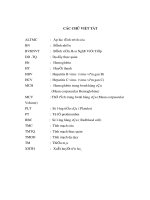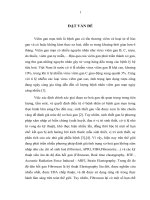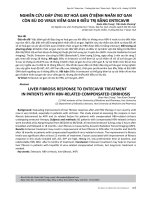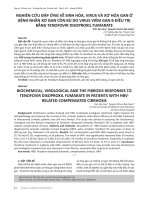tóm tắt: Nghiên cứu mối liên quan giữa cccDNA tế bào gan với HBV DNA, HBV RNA huyết tương ở bệnh nhân viêm gan B mạn tính và xơ gan do HBV
Bạn đang xem bản rút gọn của tài liệu. Xem và tải ngay bản đầy đủ của tài liệu tại đây (665.95 KB, 30 trang )
MINISTRY OF EDUCATION MINISTRY OF
AND TRAINING NATIONAL DEFENSE
MILITARY MEDICAL UNIVERSITY
DO THI LE QUYEN
RESEARCH ON CORRELATION BETWEEN
INTRAHEPATIC cccDNA, SERUM HBV RNA
AND HBV DNA IN CHRONIC HEPATITIS B
AND CIRRHOTIC PATIENTS DUE TO HBV
Specialization: Infectious and tropical diseases
Code: 9720109
SUMMARY OF DOCTORAL THESIS
HA NOI – 2024
THIS DOCTORAL THESIS WAS COMPLETED AT
VIETNAM MILITARY MEDICAL UNIVERSITY
Scientific Supervisors:
1. Asc. Prof. PhD. Hoang Tien Tuyen
2. PhD. Ho Huu Tho
1st: Contradictor: Prof. PhD. Bui Vu Huy
2nd Contradictor: PhD. Bui Tien si
3rd Contradictor: Asc. Prof. PhD. Nguyen Dang Ton
This doctoral thesis will be defended at the University ‘s
Committee of Grading at the before the Vietnam Military Medical
University at:……..on…….20….
Searching for dissertation at:
1. National Library
2. Vietnam Military Medical University ‘s library
1
INTRODUCTION
WHO 2023 estimates that 296 million people were living with
chronic hepatitis B infection in 2019, with 1.5 million new infections
each year. Hepatitis B resulted in an estimated 820 000 deaths,
mostly from cirrhosis and hepatocellular carcinoma ( HCC).
cccDNA (Covalently closed circular Deoxyribonucleic acid) plays an
important role in the persistence, maintenance and replication of the
virus in liver cells, while HBV DNA does not accurately reflect the
activity of cccDNA. In addition, cccDNA extraction and analysis
requires liver biopsy, an invasive technique that often does not
require the cooperation of many patients. Therefore, finding a marker
in plasma that can predict or represent cccDNA is extremely
necessary. HBV pgRNA (HBV RNA) is a transcription product of
cccDNA circulating in plasma. This marker has the potential to truly
reflect the activity status of cccDNA in liver cells, especially in
Vietnam, where it has not yet been established. Is there any research
on this issue?
Thereofore, we conducted the project: "Research on the
relationship between intrahepatic cccDNA and HBV DNA, HBV
RNA in patients with chronic hepatitis B and cirrhosis due to HBV"
with two goals.
1. Determine hepatic cccDNA concentration, HBV DNA viral
load and plasma HBV RNA concentration in patients with chronic
hepatitis B and cirrhosis caused by HBV.
2. Assess the relationship between hepatic cccDNA
concentration with HBV DNA viral load and plasma HBV RNA
concentration in patients with chronic hepatitis B and cirrhosis caused
by HBV.
2
NEW CONTRIBUTIONS OF THE THESIS:
This thesis is the first study in Vietnam to quantify cccDNA
levels in liver cells in patients with chronic hepatitis B and cirrhosis
caused by HBV. The cccDNA concentration in the two groups
HBMT and cirrhosis were 1.61 ± 0.40 and 1.56 ± 0.39
log10copies/cell, respectively. cccDNA is correlated with HBV
RNA, HBV DNA in descending order as follows: in the same two
groups, the correlation between cccDNA and HBV RNA is r= 0.57;
p<0.01), then cccDNA with (HBV DNA+RNA) is r=0.47; p<0.01
and the lowest correlation coefficient is between cccDNA and HBV
DNA (0.21; p= 0.01). Thus, it can be seen that HBV RNA is a
valuable marker to evaluate the level of cccDNA activity in patients
with HBV infection in Chronic Hepatitis B and cirrhosis caused by
HBV.
STRUCTURE OF THE THESIS
The thesis consists of 122 pages with 4 chapters, 36 tables, 9
figures and 10 charts, 2-pages introduction; 34 pages overview; 26
pages subjects and methods; 28 pages discussion; 2 pages
conclusion; 1 page recommendations, 1 page: limitations of the
study, 128 references.
CHAPTER 1 – OVERVIEW
1.1. Situation of HBV infection in the world and in Vietnam
1.1.1 Situation of HBV infection in the world
According to the World Health Organization (2023), there are an
estimated 296 million people who are chronic carriers of hepatitis B
virus (Hepatitis B virus: HBV) globally. Chronic HBV infection is
also the cause of about 820,000 deaths each year related to
complications of the disease such as chronic hepatitis B (CHB),
cirrhosis and hepatocellular carcinoma (HCC).
3
1.1.2. Situation of HBV infection in Vietnam
Vietnam is one of the countries with a high HBV infection rate in
the region and suffers from severe consequences caused by HBV
infection. Data from the Vietnamese Ministry of Health in 2019
reported that the proportion of chronic HBV infection ranged from 6
– 20% of the total population, equivalent to about 8 million people.
1.2. Pathogenesis and progression of chronic HBV infection
1.2.1. Pathogenesis of disease caused by HBV
- Life cycle of HBV
During chronic HBV infection, cccDNA is used as a template
to synthesize messenger RNAs with different sizes 3.5; 2.4; 2.1 and
0.7kb. These RNAs are attached to their tails and move to the
cytoplasm and perform their functions. Once pgRNA is synthesized,
it is packaged in the nucleocapsid and translocated into the cytosol,
then initiate genome replication
The responses of HBV-specific T lymphocytes and B
lymphocytes are decisive factors in eliminating free virus and
infected liver cells and play a role in long-term immune control of
HBV. During chronic HBV infection, the virus will hide and inhibit
the antiviral ability of the adaptive and innate immune systems
through different mechanisms, thereby achieving continuous,
simultaneous replication. The host also exhibits dysfunction of
various immune cells.
1.2.2. Natural course of chronic HBV infection
Chronic HBV infection undergoes 5 stages: stage 1 the
HBeAg-positive chronic HBV infection stage or, according to
previous terminology, the immune tolerance stage. Stage 2: HBV
stage with HBeAg positive, stage 3: Chronic HBV infection with
HBeAg negative (corresponding to inactive viral carrier stage), stage
4: HBV stage with HBeAg negative and HBsAg negative stage in
which the disease is characterized by negative HBsAg. These periods
are classified according to different characteristics based on HBeAg
4
carrier status, ALT elevation and ALT levels as well as
histopathological damage.
1.3. Chronic hepatitis B and cirrhosis due to HBV
1.3.1. Chronic hepatitis B virus
HBV is a condition of inflammation and necrosis of liver cells
caused by the existence of HBV lasting more than 6 months. Most
HBV patients have poor clinical manifestations such as only transient
fatigue, sometimes loss of appetite, bloating..., AST and ALT
activities do not increase or slightly increase by 2-5 times the high
threshold of the normal values.
1.3.2. Cirrhosis caused by HBV
Cirrhosis caused by HBV is also known as parenchymal
cirrhosis or post-necrotic cirrhosis, fibrotic lesions originate from the
portal space enter the liver parenchyma to replace necrotic tissue.
The liver tissue proliferates, creates large and small neoplastic
nodules of irregular diameter, usually > 3mm, but mainly large
nodules, so it is also called large regenerative cirrhosis.
1.4.1. HBV DNA
In clinical practice, HBV DNA level plays a very important
role in assessing viral replication, as well as prescribing and
monitoring antiviral treatment. Persistent high viral load is closely
related to increased risk of cirrhosis and liver cancer. HBV DNA
level is considered as one of a significant criteria to access treatment
response.
1.4.2. HBV RNA
Pregenomic RNA (pgRNA) is a direct transcription product of
the covalent closed-circle cccDNA of hepatitis B virus, playing an
important role in the amplification and replication of the viral
genome. pgRNA can be reversely transcribed into rcDNA by HBV
DNA polymerase to continue a new life cycle. Therefore, blocking
reversely transcription will not affect the release of pgRNA into
serum. Different from serum HBsAg, serum pgRNA with molecular
5
weight of 3.5 kb is only produced from cccDNA, therefore, it can
accurately reflect the transcription status of HBV cccDNA in liver
cell nuclei.
1.4.3. cccDNA
cccDNA is one of the most important components of HBV,
which can exist in HBV-infected liver cells and serves as a template
for virus replication. It is a key factor in the virus life cycle and
persistent HBV infection or recurrence of hepatitis after stopping
antiviral therapy because cccDNA is very stable in nondividing
human liver cells. Furthermore, cccDNA can persist throughout the
entire life cycle of liver cells, thus serves as a persistent viral
reservoir.
1.5. Methods for quantifying HBV RNA and cccDNA
1.5.1. Some methods to quantify HBV RNA in peripheral blood of
HBV patients
Some specific techniques have been and are being applied:
- PCR/Realtime PCR technique based on the 3' RACE
principle
- RT-qPCR technique
- Droplet digital PCR technique
- Some other techniques such as QuantiGene, Indirect
Quantitative Technique...
1.5.2. Methods for quantifying cccDNA
- FISH method
- qPCR method
- qPCR+ PDS method
- qPCR+ T5 exonuclease method
- Direct droplet method
1.7. Studies on cccDNA and HBV DNA, HBV RNA in patients
with chronic HBV infection in the World and Vietnam
1.7.1. Research around the world
Since 1988, Hadchouel M. and CS have detected HBV-RNA
6
in circulating mononuclear cells in peripheral blood. By 1996, HBV-
RNA was reported by Kock J. and colleagues to be found in the
plasma of patients with chronic HBV infection. In 2000, Mei S. D.
and CS used RT-PCR technique to detect HBV-RNA circulating in
the peripheral blood of patients. Author Jei L. et al (2017) analyzed
the relationship between HBV DNA, cccDNA in the liver and serum
HBsAg levels in HBV patients with HBV DNA below the detection
threshold after taking oral antiviral drugs. The author's results
showed that cccDNA and HBV DNA in the liver in HBV patients
were higher than in cirrhotic patients. cccDNA had a positive
correlation with HBsAg in the group of patients with negative
HBeAg. Author Hongxing H. (2018) used HBV DNA combined with
RNA to reflect the activity of cccDNA in acute hepatitis B patients
and HBV patients.
1.7.2. Research in Vietnam
In Vietnam, plasma HBV-RNA is a new biomarker. In 2018,
author Nguyen Van Dien detected plasma HBV-RNA in 61.54% of
HBV patients with an average concentration of 6.29 ± 1.42 log10
copies/mL.
In 2020, author Nguyen Hong Thang and colleagues
announced the detection of plasma HBV-RNA in 86.49% of patients
at the initial time. Plasma HBV-RNA levels were higher in the
HBeAg-positive group than in the HBeAg-negative group. There
have been no studies on cccDNA in patients with chronic HBV
infection in Vietnam.
Chapter 2.
RESEARCH SUBJECTS AND METHODS OF THE STUDY
2.1. Subjects of the study
135 patients, of which 105 patients were diagnosed with CHB
and 30 patients were diagnosed with cirrhosis.
2.1.1. Patient selection criteria
- Patients with CHB according to the 2019 Ministry of Health
7
guidelines
- HBsAg (+) ≥ 6 months or HBsAg (+) and anti-HBc IgM (-).
- HBV DNA positive.
- There is evidence of progressive histopathological damage,
cirrhosis... without other causes.
- Patients with cirrhosis due to HBV according to Bacon 2008 [22].
Select patients with cirrhosis according to standards
- HBsAg (+) > 6 months or HBsAg (+) and anti-HBc IgM (-).
- Histopathology: F4 follow Metavir score
- All patients have never received antiretroviral treatment.
2.1.2. Exclusion criteria
- Pregnant women, breastfeeding women, patients under 16
years old.
- Co-infection with other hepatitis viruses or HIV. Patients
with liver damage due to other causes (alcohol, drugs, chemicals,
autoimmune...).
- Patients with contraindications for liver biopsy (coagulation
disorders, severe liver failure, ascites...). - Patients who do not agree
to participate in the study.
2.1.3. Research time and location
- Implementation time: from December 2017 to April 2020.
- Research location: Department of Infectious Diseases,
Military Hospital 103 and Department of Gene and Genetic
Technology, Military Medical and Pharmaceutical Research Institute,
Vietnam Military Medical University
2.2. Research Methods
2.2.1. Research design: Descriptive, prospective study.
2.2.2. Study sample size, collection time and treatment regimen
- Sample size: 135 patients
- Time of sample collection: before the patient has a liver
8
biopsy
2.2.3. Research indicators and assessment standards
2.2.3.1. Research targets
- Age, gender, fatigue, jaundice, right lower quadrant pain.
- Plasma HBV-DNA concentration
- Plasma HBV-RNA concentration
- intrahepatic cccDN concentration
- HBeAg, platelets, HAI score, fibrosis.
- AST, ALT and total Bilirubin.
2.2.3.2. Grouping research indicators
- Age, gender, enzymes: AST, ALT, Bilirubin
- Platelets: <140, ≥ 140; HBeAg: Positive/negative
- HAI histology index scale, Fibrosis
- cccDNA: log10copies/cell, HBV DNA: < 5, ≥5log10copies/
mL;
- HBVRNA: Negative (<2log10copies/ml), Positive (≥
2log10copies/ml)
- HBV RNA + DNA: Total (HBV RNA + HBV DNA)
log10copies/ml)
2.2.4. Engineering principles and processes
2.2.4.1. Procedure for quantifying plasma HBV RNA levels
- Process principle: Based on one-step realtime PCR technique,
with a primer/probe set that pairs with the S gene region of HBV,
specially designed to help select the newly created cDNA sequence from
HBV- pgRNA, which does not pair and misamplifies HBV-rcDNA.
- HBV-pgRNA positive control sample: artificially synthesized
from the published HBV subtype B sequence under code
MF674382.1
- Detection threshold: 2 log10 copies/mL. The technical
specificity of the procedure is 100%.
9
2.2.4.2. Principle of quantitative testing for plasma HBV DNA
concentration:
- Based on realtime PCR Taqman probe technique, using HBV
Real-TM Quant Dx kit (Sacace Biotachnologies Srl, Como, Italy), on
SaCycler-96™ system, Sacace, Italy.
- Linear range from 60 – 108copies/mL; The quantitative
threshold of the test is 60copies/mL.
2.2.4.3. Test principle to quantify HBV cccDNA concentration in liver
cells
Our procedure for quantifying cccDNA in the liver is performed
according to the method published in 2011 by author Zhong.
The amplification process consists of two steps as follows. (1)
10μl of PSl of PSAD-treated DNA was combined with primers at a
concentration of 0.5μl of PSmol/l each and 1μl of PSl of reaction buffer.
Quantification of HBV cccDNA in liver cells by quantitative real-
time PCR method: Using the product after the RCA process as a
template, HBV cccDNA is further amplified a second time and
quantified by real-time PCR with designed primer pairs. cccDNA-
specific (PCR product nucleotide positions: 1523-1870) and an
additional Taqman probe with a sequence region located between
two direct repeats, DR1 (at nucleotide position 1826) and DR2 (at
position 1826). nucleotide position 1592), belonging to the HBV
virus gene.
2.2.5. Data analysis method
- Use MedCalc software version 20.019 (MedCalc Software
Ltd, Ostend, Belgium) for statistical analysis. Statistics by number,
percentage, median - quartiles.
- ROC curve analysis estimates predictive value. Multivariable
logistic regression analysis verifies independent effects.
2.2.6. Research ethics issues
10
The PhD student's thesis uses part of the data from the project code
01C-0808-2017-3, which has been approved by the Ethics Council in
Biomedical Research of the Military Medical Academy (according to
decision No. 780/ Decision-HVQY dated March 28, 2018).
CHAPTER 3 - RESULTS
3.1. General characteristics of research subjects
3.1.2. Characteristics of paraclinical indicators
Characteristics CHB Cirrhosis p
n (%) n (%) > 0,05
HBeA Negative 46 (43,8%)
59 (56,2%) 13 (43,3%)
g positive 105 17 (56,7%)
Total 30
Characteristics of HBeAg in the two groups of CHB and
cirrhosis did not differ.
11
3.2. Intrahepatic cccDNA concentration, HBV DNA load, serum
HBV RNA concentration in studied patients
3.2.1. Intrahepatic cccDNA concentration
p>0,05
cccDNA (log10copies/tb) 1.65 1.61
1.6 1.56
1.55
1.5
1.45
1.4
n= 105 n=30
VGBMT Xơ gan
Figure 3.1 Intrahepatic cccDNA concentration in CHB and Cirrhosis
groups are equal
Table 3.9. Relationship between liver cell cccDNA concentration
and research criteria in the CHB group
characteristic cccDNA
(log10copies/tb)
X ± SD P
< 40 1,67 ± 0,41
(n=66)
Age 0,04
(year) ≥ 40 1,51 ± 0,36
(n=39)
HBeAg 1,54 ± 0,35 0,10
Negative
(n=46)
12
PLT Positive 1,67 ± 0,43
(G/L) (n=59)
< 140 1,67 ± 0,37
ALT (n=12) 0,56
(U/L)
≥ 140 1,60 ± 0,41
(n=93)
< 80 1,48 ± 0,23
(n=13) 0,21
≥ 80 1,63 ± 0,41
(n=92)
Intrahepatic cccDNA in the group of patients aged < 40 years
was higher than the group ≥ 40 years old, the difference was
statistically significant with p < 0.05. However, there was no
difference in Intrahepatic cccDNA levels between the two groups of
patients classified by HBeAg carrier status, platelet levels and ALT
levels (p> 0.05
3.2.2. Serum HBV RNA levels in two groups of studied patients
Table 3.13. Serum HBV RNA levels in two groups of studied patients
CHB Cirrhosis
characteristic (n=105) (n=30) P
n(%) n(%)
X ± SD 4,88 ± 1,65 4,44 ±1,38 0,18*
(Min - (1,99-8,71) (1,99-7,91)
max)
HBV RNA Negative 13 (12,4) 03 (10,0)
(log10copies/ml) (n=16) 92 (87,6) 27 (90,0)
Positive
(n=119)
p > 0,05**
HBV RNA levels in the CHB group were higher than the
cirrhosis group, but the difference was not statistically significant.
13
Positive HBV-RNA accounted for higher proportion in both groups,
at 87.6% and 90.0%, respectively.
Table 3.16. Relationship between plasma HBV RNA concentration
and research criteria in the CHB group
HBV RNA (log10copies/ml)
characteristic X ± SD P
Age < 40 5,15 ± 1,75
(year) (n=66) 0,02
≥ 40 4,41± 1,35
(n=39)
HBeAg Negative 4,19± 1,45 <0,001
(n=46) 5,42 ± 1,59
Positive
(n=59)
PLT < 140 5,09 ± 1,19 0,64
(G/L) (n=12) 4,85 ± 1,69 <0,01
3,44 ± 1,26
ALT ≥ 140 5,08 ± 1,59
(U/L) (n=93)
< 80
(n=13)
≥ 80
(n= 92)
In CHB patients: plasma HBV RNA levels in the HBeAg
Positive and ALT ≥ 80 group were higher than the HBeAg negative
and ALT < 80 U/L group, the difference was statistically significant
p < 0.001. No difference was found in HBV RNA levels according to
age and platelet groups.
14
3.2.3. HBV DNA load in two patient groups studied
Table 3.19. HBV DNA load in two patient groups studied
characteristic CHB (n=105) Cirrhosis (n=30) p
n (%)
n (%)
HBV DNA < 5 35 06 0,16*
(log10copie (n=41) (85,4) (14,6)
s/ml) ≥ 5 70 24
(n=94) (74,5) (25,5)
Median - 5,97 5,98 0,86**
quartiles (4,65- 7,11) (5,35-7,51)
The proportion of patients with HBV DNA load ≥
5log10copies/ml and HBV DNA concentration in the two groups CHB
and Cirrhosis were similar.
3.3. Relationship between cccDNA concentration with HBV DNA
and HBV RNA in two groups of patients studied
3.3.1. Relationship between cccDNA concentration and HBV DNA
viral load in patient groups
Table 3.24. Characteristics of cccDNA concentration according to
plasma HBV DNA load in studied patients
HBV DNA
characteristic (log10copies/ml) p
< 5 ≥ 5
cccDNA CHB 1,44 ± 0,35 1,69 ± 0,40 0,002*
(log10copi (n= 105) (0,75-2,40) (0,70-2,47) 0,89**
(X ± SD)
es/tb) min - max 1,49 1,52
(1,35-1,57) (1,29- 1,79)
Cirrhosis
(n= 30)
(Median - quartiles)
*Student’s T- Test, ** Mann-Whitney Test
15
The cccDNA concentration in the CHB group with HBV DNA
≥ 5log10copies/ml was higher than the HBV DNA <5log10copies/ml
group (1.69 ± 0.40 vs. 1.44 ± 0.35 log10copies/ml). The difference is
statistically significant with p < 0.01. Meanwhile, in the Cirrhosis
group, no difference in cccDNA was observed according to the
increase in HBV DNA load, p>0.05.
cccDNA (log10copies/tb) r=0,21, p< 0,05
4,00 2,00 4,00 6,00 8,00 10,00
3,00
2,00
1,00
-
-
HBV DNA (log10copies/ml)
Chart 3.3. Correlation between intrahepatic cccDNA concentration
and plasma HBV DNA load in both groups
cccDNA logcopies/tb Nhóm VGBMT cccDNA logcopies/tb Nhóm Xơ gan
r=0,21;p=0.03 r=0,02,p=0,90
3 4
2 3
1 2
0 1
0
HBV DNA log10copies/ml 2.00 3.00 4.00 5.00 6.00 7.00 8.00 9.00
HBV DNA (log10copies/ml)
Chart 3.4. Correlation between intrahepatic cccDNA concentration
and plasma HBV DNA load in CHB and Cirrhosis groups
16
According to the 3 charts above, it can be seen that cccDNA
and HBV DNA have a weak correlation in the general group and the
CHB group (r = 0.21; p < 0.05), whereas no correlation can be
witnessed in Cirrhosis one.
Table 3.26. cccDNA concentration according to HBV RNA levels in
two study groups
HBV RNA
(log10copies/ml) p
<0,001*
Negative Positive
(n=16) (n=119)
(log10copies/tb)cccDNA CHB (n=105) 1,17± 0,23 1,67± 0,38
(X ± SD)
Cirrhosis (n=30) (Median – 1,10 1,55 0,02
(1,08-1,25) (1,41-1,80 )
quartiles)
Intrahepatic cccDNA concentration in the group of patientscccDNA (log10copies/tb)
with HBV RNA Positive was higher than that in the group of
patients with HBV RNA Negative in both HBV and Cirrhosis
groups, the difference was statistically significant with p < 0.001 and
p < 0.05.
r=0,57, p< 0,01
4.00
3.00
2.00
1.00
-
HBV RNA (log10copies/ml)
17
Chart 3.5. Correlation between cccDNA and HBV RNA in all
studied patients (n=135)
In the two patient groups: cccDNA and HBV RNA have a
positive, quite strong correlation with r=0.57, p<0.01.
HBVRNA (log10copies/ml)3 r=0,55, p< 0,01
cccDNA (log10copies/TB)
2.5
2 f(x) = 0.13 x + 0.96 4
1.5 3
R² = 0.3
1
2
0.5 1
01 2 3 4 5 6 7 8 90110 2 3 4 5 6 7 8 9
cccDNA log10copies/TB HBVRNA (log10copies/ml)
(CHB) (Cirhosis)
Chart 3.6. Correlation between intrahepatic cccDNA concentration
and plasma HBV RNA in the CHB and Cirrhosis groups
In the general group: cccDNA and HBV RNA have a positive,
quite strong correlation with r = 0.57, p < 0.01. Intrahepatic cccDNA
with plasma HBV RNA in the CHB group had a moderate positive
correlation (r=0.49,p<0.01). In the Cirrhosis group cccDNA and
HBV RNA have a strong positive correlation, with a correlation
coefficient of r=0.55; p<0.001.









